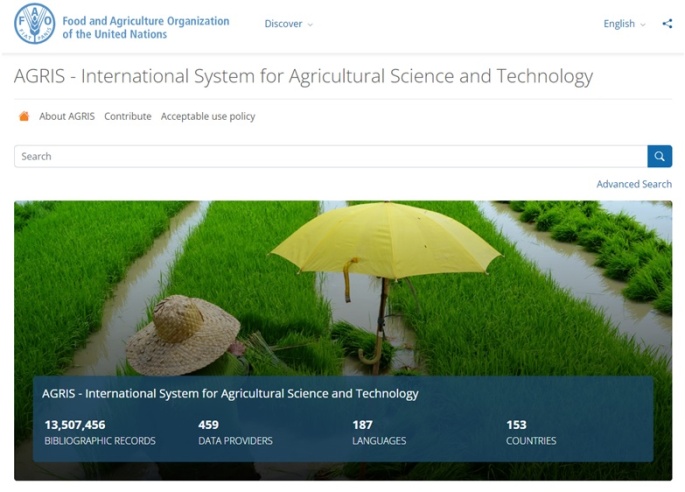Introducing AGRIS 2.0!
14/06/2023

FAO
FAO’s team responsible for AGRIS are delighted to announce the launch of AGRIS 2.0 on Tuesday 13 June.
This new and improved version of AGRIS, which boasts significant changes to the user interface as well as to the information technology (IT) architecture underpinning the database, will benefit both users and data providers.
Incorporating a more user-friendly search interface that makes searching for bibliographic references (records) in the database easier, more intuitive and less time consuming, the database itself is founded on a more flexible and adaptive IT architecture that permits more responsive and efficient indexing and curation of records.
User interface
Available in all six official FAO languages, a visually appealing user or search interface can be used to effectively search the 13.5 million records indexed in the multilingual AGRIS database. Modelled on search bars that characterise popular search engines, the AGRIS search bar enables users to search the database without immediate recourse to filters. Filters to narrow a search are available in an easily accessible advanced version of the search bar.
Designed with the aim of ensuring that vital information about AGRIS is available and easily accessible to the user, the landing page features a description of AGRIS and provides answers to three pertinent – especially for those unfamiliar with AGRIS – questions:
- Who provides the data in the database?
- What kinds of records are indexed in the database?
- Who uses the database?
Search results
The search results page provides a more intuitively displayed and clearly demarcated set of filters – spanning publication dates, language, data provider, country the data is from and AGROVOC (the multilingual agricultural thesaurus) search terms – on the left of the page.

The page relating to each individual search result or record displays all the information in a clear and more easily comprehensible way. Additionally, multilingualism, a defining characteristic of AGRIS, is accentuated wherever possible in the way titles and abstracts are displayed in the languages relevant to the record.

The new IT architecture behind the database
The benefits of AGRIS 2.0 are not limited only to users. Data providers also stand to benefit from the advantages that accrue from the new IT architecture that shapes the functioning and structure of the database. A few notable benefits include:
- Fast turnaround, with close-to-real time indexing of metadata submitted by email.
- Enhanced metadata format flexibility for those contributing metadata by email
- this means that metadata of different resources – for example, different journals from the same organization – could be in different (from a list of permissible formats) metadata formats.
- Increased flexibility in the way metadata is contributed
- metadata of different resources from the same data provider can be submitted in different ways, for example, one journal could submit metadata by email in one of the permissible metadata formats while another could have its metadata automatically harvested (in Dublin Core or AGRIS AP metadata format).
- Greater ability to modify metadata and curate collections.
These advantages ensure that the collections of organizations are up to date in the AGRIS database, thereby increasing their global visibility.
The new AGRIS 2.0 can be accessed HERE.
